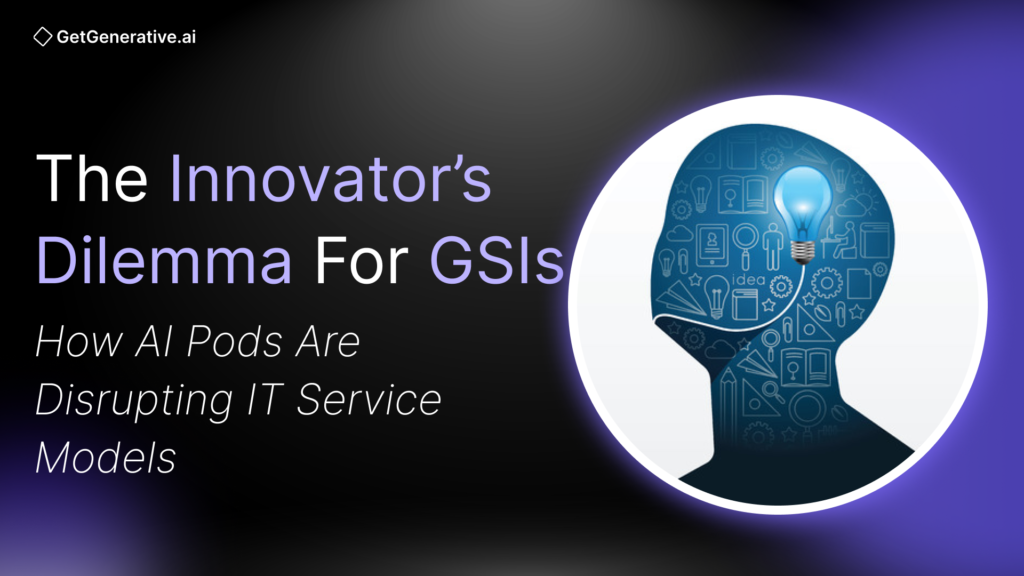The Innovator’s Dilemma for GSIs: How AI Pods Are Disrupting IT Service Models
In a bold move, Globant has launched “AI Pods”—autonomous AI agents overseen by human experts—to automate significant portions of its delivery operations. Offered through a subscription-based, token-metered model, this innovation marks what CEO Martín Migoya describes as a “radical departure” from traditional IT services.
Instead of billing by the hour, Globant is now selling AI-driven outcomes.
But the market’s reaction has been anything but enthusiastic.
Globant’s stock has dropped over 50% in the past six months, including a single-day 23% plunge following its Q1 2025 earnings miss and reduced full-year guidance. Once trading near $238, shares now hover around $100, reflecting investor skepticism around the execution risks of this AI pivot.
Analyst sentiment is mixed. Goldman Sachs, for example, cut its price target from $225 to $120 and downgraded the stock to Neutral. Other firms retained Buy ratings, but with tempered expectations. Some observers argue that Globant is undervalued, citing solid long-term profit potential, but few dispute that the company must now prove that its AI Pods can deliver both growth and margins to justify this radical shift.
The Real Wake-Up Call for Legacy GSIs
Globant’s transformation is not just about one company—it highlights a brewing crisis for legacy Global System Integrators (GSIs). The success playbook of the past, built around scaled human labor, pyramid structures, and hourly billing, is now colliding with a new delivery paradigm: AI-native service models.
These AI-powered disruptors—be they upstart SaaS vendors or hybrid tech firms—offer faster, cheaper, and more flexible solutions. Their models decouple growth from headcount and prioritize automation over human scale. This exposes a central tension for incumbents: the very structures that once enabled their dominance now threaten their adaptability.
Consider the dilemma: if AI agents can perform tasks traditionally handled by large delivery teams, what happens to the tens of thousands of employees that legacy GSIs depend on for revenue? With billable hours as the primary metric of success, adopting AI at scale could cannibalize their existing business model.
One analyst framed it succinctly: “Most big IT services firms were built on human leverage. That leverage is now under threat.”
Why Transformation Is Harder Than It Looks
Despite widespread interest in AI, legacy GSIs face serious internal barriers to becoming truly AI-native.
- Structural Inertia: Their operating models are optimized for managing large human workforces, with layers of project managers, compliance checks, and utilization tracking. This structure is poorly suited for fast, iterative AI workflows.
- Cultural Resistance: Business incentives still reward increasing headcount and maximizing billable hours. Automation, paradoxically, can look like a threat to growth, especially in the short term.
- Process Complexity: Long approval chains, risk-averse policies, and slow experimentation cycles make rapid AI adoption difficult.
- Client Expectations: Clients still associate these firms with dependable, people-intensive service delivery. Breaking that mold requires careful repositioning and trust-building.
Globant’s leadership, however, is betting that this disruption is necessary and profitable. “We are leading a fundamental shift,” Migoya stated, highlighting their belief that AI can unlock far more value than traditional methods.
What It Really Takes to Be AI-Native
Becoming an AI-native services company is more than just adopting new tools. It’s a ground-up reinvention. Here’s what that transformation entails:
1. Reimagining the Delivery Model
Shift from time-and-materials billing to continuous, outcome-driven delivery. Instead of charging for hours worked, AI-native firms monetize results. Globant’s AI Pods, for instance, offer token-based access to AI capabilities, aligning revenue with value delivered, not effort expended.
2. Embedding AI in Tooling & Platforms
AI-native operations are powered by platforms that automate coding, testing, data processing, and more. Globant’s internal GEAI platform deploys intelligent agents like “Globant CODA” that generate code, test software, and deploy updates, shortening software cycles dramatically. Other firms must invest in similar AI infrastructure or risk falling behind.
3. Redesigning Team Structures
Hierarchical, role-specialized teams give way to smaller, agile units where AI augments every contributor. The workforce transitions from manual executors to AI trainers and curators. New roles—like prompt engineers and AI model supervisors—emerge, while traditional roles evolve to require AI fluency.
4. Overhauling Commercial Models
Billing transforms into usage-based or outcome-based contracts. Providers might charge based on delivered business KPIs, token usage, or subscription tiers. Internal incentives also shift, rewarding efficiency, reusability, and IP creation instead of hours billed.
Also Read – Reinventing Salesforce Implementation with the AI Native Delivery Framework
Will the Giants Adapt—or Be Disrupted?
The stakes are high. Globant’s AI-native model may still be in its early innings, but its implications are profound. If successful, it could serve as a template for the entire services industry. The model promises faster turnaround, higher margins, and longer client retention—but only if executed well.
For legacy GSIs like Accenture, Infosys, and Deloitte, the path forward is clear but challenging. They must decide whether to proactively disrupt themselves or risk being leapfrogged by more agile, AI-native competitors.
As the billable hour era fades, the next few years will define which firms can truly evolve. The Innovator’s Dilemma is real—and this time, it’s powered by AI.



